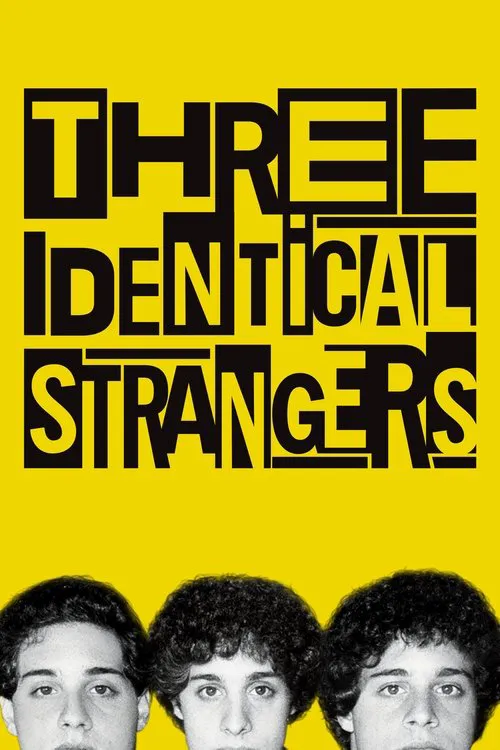Three Identical Strangers

Plot
In January 1980, three unsuspecting young men from Queens, New York, walked into a television studio in Long Island, unaware that their lives were about to experience a profound change. Robert Shafran, Eddy Galland, and David Kellman were three complete strangers who shared a striking resemblance to one another. The coincidence was more than startling; it sparked a series of events that would challenge their identities, question the very principles of family, and expose a sinister human experiment. The meeting took place in a New York City news studio, where Robert, a 19-year-old art student, had gone to visit a new school that he had heard was a place to enroll for students from New York with mental or cognitive difficulties – though he was not attending himself. When he walked in, a crowd began whispering, and then they started staring. At first, Robert thought he was somehow a celebrity, but when he realized that this reaction was due to his remarkable similarity to one of his classmates, he was both stunned and puzzled. This young man turned out to be Eddy Galland, a 19-year-old who attended Sullivan High School. They spent hours talking to one another that day, both men stunned by the incredible coincidence, as well as how similar they seemed to be. Days went by, and the news of the twins began to spread. Eddy's brother, Arthur, was approached by a reporter who noticed their resemblance, and they soon found out about another young man from Queens, David Kellman. They decided to get in touch, and after the three young men met, there was no doubt in their minds – they were indeed identical triplets, separated at birth. This incredible revelation catapulted Robert, Eddy, and David to international fame. They were interviewed by major news organizations, and their story was published in newspapers worldwide. The young men enjoyed their newfound fame, often performing at charity functions and appearing on television shows. The media frenzy surrounding the triplets soon raised a storm of questions about their past. Who were their biological parents? Why were they separated at birth? The answer to these questions seemed to be more complex than anyone had initially anticipated. After conducting an investigation, it was discovered that the three young men were just the tip of the iceberg of a secret experiment conducted by the renowned child psychologist Dr. Peter B. Neubauer, working alongside a Dr. Leon Eisenberg, and with the help of the Child Development Center in Manhattan. What seemed to be a miraculous chance encounter turned out to be the result of a calculated decision to separate the triplets at birth, as part of a psychological study. The plan was to study the effects that environment and upbringing had on children from similar backgrounds, by splitting identical triplets into two distinct family environments. While their natural bond would make for an interesting and potentially groundbreaking case for study, the researchers never considered the long-term psychological cost to the children themselves, who were unaware of the true motivations behind their reunion. In the months that followed, as the fame continued, the young men found themselves struggling with issues of identity and belonging. Robert, who had grown up in a loving family, now wondered about his birth mother and whether he had any siblings. Eddy, on the other hand, began questioning his place within his adopted family, whose reactions to his new twin brothers left much to be desired. David, who had grown up in a more troubled home, longed for a family that accepted and loved him unconditionally. This journey took the three identical strangers through emotional highs and lows, often causing them to question the nature of their existence. It challenged the basic tenets of their understanding of their lives and their relationships with their families. But the true extent of this experiment began to emerge as the twins continued their investigation into their past. They eventually discovered how their lives were manipulated to test the effects of identical triplets' reactions to different environments. It was later found that the researchers involved monitored the behavior of the triplets closely, observing every reaction, conversation, and interaction. This constant observation made it hard for Robert, Eddy, and David to form their own genuine identities, as every action or movement was seen as a 'data point' to contribute to their ongoing study. Their search for answers culminated with a meeting with Dr. Peter Neubauer, where the three men finally uncovered the shocking truth behind their separation. They were no longer mere 'data points' but three human beings deserving of love, care, and respect. The aftermath of their encounter would prove to be transformative. The revelation shook the very foundations of the experiment, which had gone on to influence various institutions and research studies. This was particularly true for Dr. Leon Eisenberg, who would later become an influential voice in the academic world, yet, with a shadow cast by this questionable study. In the face of this disturbing truth, Robert, Eddy, and David had no choice but to grapple with the implications. They decided to file a lawsuit against the institutions involved, to uncover further information about their true past and to demand answers. This decision ultimately led to the release of documents revealing more evidence of Dr. Neubauer's study. For the three men, who had been unwitting participants in a human experiment at the time of its conception, their search for identity, for love, and for truth became an extraordinary tale of resilience and perseverance. Despite having overcome incredible obstacles, the bond between Robert, Eddy, and David would forever be a testiment to the strength and power of family, as well as the importance of confronting our collective history with an unwavering commitment to the truth.
Reviews
Recommendations




